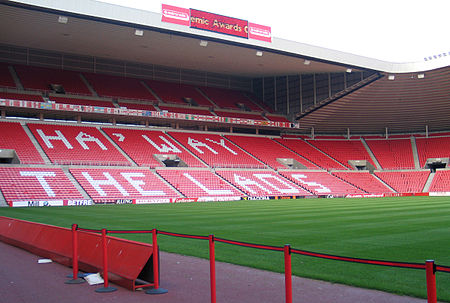Stadium of Light

The Stadium of Light is an all-seater football stadium in Sunderland, England, and the eighth and current home to Sunderland A.F.C. With space for 49,000 spectators, the Stadium of Light is the ninth largest football stadium in England. The stadium primarily hosts Sunderland A.F.C. home matches. The stadium was named by chairman Bob Murray to reflect the coal mining heritage of the North East and the former Monkwearmouth Colliery site on which it stands. A Davy lamp monument stands at the entrance to reflect the coal mining industry that brought prosperity to the town.As well as hosting Sunderland games, the stadium has hosted three matches for the England national football team, as well as an England under-20, an England under-21 and an England women's team match. With an original capacity of 42,000, it was expanded in 2000 to seat 49,000. Its simple design is apparently to allow for redevelopments up to a capacity of 64,000. The attendance record at the Stadium of Light is 48,353 set on 13 April 2002, when Sunderland played Liverpool with the visitors running out 1–0 winners. Along with hosting football matches, the stadium has played host to performers such as Beyoncé, Rihanna, Oasis, Take That, Kings of Leon, Coldplay, Spice Girls and Elton John. The ground also holds conference and banqueting suites, the Black Cats Bar, and a club shop selling Sunderland merchandise.
Excerpt from the Wikipedia article Stadium of Light (License: CC BY-SA 3.0, Authors, Images).Stadium of Light
Vaux Brewery Way, Sunderland Millfield
Geographical coordinates (GPS) Address Nearby Places Show on map
Geographical coordinates (GPS)
| Latitude | Longitude |
|---|---|
| N 54.9144 ° | E -1.3882 ° |
Address
Vaux Brewery Way
SR5 1SN Sunderland, Millfield
England, United Kingdom
Open on Google Maps








